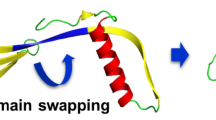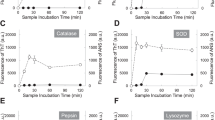Abstract
Thiol protease inhibitors (cystatins) are implicated in various disease states from cancer to neurodegenerative conditions and immune responses. Cystatins have high amyloidogenic propensity and they are prone to form fibrillar aggregates leading to amyloidosis. Particularly challenging examples of such disorders occur in type 2 diabetes, Alzheimer’s and Parkinson’s diseases. The aim of the present study is to find an interaction between the compound methylglyoxal (MG) which is particularly elevated in type 2 diabetes with caprine brain cystatin (CBC). Results have shown that elevated concentration of MG forms amyloid aggregates of CBC. This was achieved by allowing slow growth in a solution containing moderate to high concentrations of MG. When analysed with microscopy, the protein aggregate present in the sample after incubation consisted of extended filaments with ordered structures. This fibrillar material possesses extensive β-sheet structure as revealed by far-UV CD and IR spectroscopy. Furthermore, the fibrils exhibit increased Thioflavin T fluorescence.









Similar content being viewed by others
Abbreviations
- MG:
-
Methylglyoxal
- CBC:
-
Caprine brain cystatin
- AGEs:
-
Advanced glycation end products
- AD:
-
Alzheimer disease
- PD:
-
Parkinson’s disease
- mM:
-
Millimolar
References
Amin F, Khan AA, Rizvi SJ, Bano B (2011) Purification and characterization of buffalo brain cystatin. Protein Pept Lett 18:210–218
Asplund K, Hagg E, Helmers C, Lithner F, Strand T, Wester PO (1980) The natural history of stroke in diabetic patients. Acta Med Scand 207:417–424
Beisswenger BG, Delucia EM, Lapoint N, Sanford RJ, Beisswenger PJ (2005) Ketosis leads to increased methylglyoxal production on the Atkins diet. Ann N Y Acad Sci 1043(20):1–10
Bernstein HG, Kirschke H, Wiederanders B, Pollak KH, Zipress A, Rinne A (1996) The possible place of cathepsins and cystatins in the puzzle of Alzheimer disease: a review. Mol Chem Neuropathol 3:225–247
Bhat SA, Sohail A, Siddiqui AA, Bano B (2014) Effect of non-enzymatic glycation on cystatin: a spectroscopic Study. J Fluoresc 24:1107–1117. doi:10.1007/s10895-014-13-91-2
Candiloros H, Muller S, Zeghari N, Donner M, Drouin P, Ziegler O (1995) Decreased erythrocyte membrane fluidity in poorly controlled IDDM. Influence of ketone bodies. Diabetes Care 18:549–551
Carrotta R, Bauer R, Waninge R, Rischel C (2001) Conformational characterization of oligomeric intermediates and aggregates in β-lactoglobulin heat aggregation. Prot Sci 10:1312–1318
Cook LJ, Davies J, Yates AP, Elliott AC, Lovell J, Joule JA, Pemberton P, Thornalley PJ, Best L (1998) Effects of methylglyoxal on rat pancreatic beta-cells. Biochem Pharmacol 55:1361–1367
Coussons PJ, Jacoby J, McKay A, Kelly SM, Price NC, Hunt JV (1997) Glucose modification of human serum albumin: a structural study. Free Radic Biol Med 22:1217–1227
Damiran D, Yu P (2011) Molecular basis of structural makeup of hulless barley in relation to rumen degradation kinetics and intestinal availability in dairy cattle: a novel approach. J Dairy Sci 94:5151–5159
Du J, Suzuki H, Nagase F, Akhand AA, Yokoyama T, Miyata T, Kurokawa K, Nakashima I (2000) Methylglyoxal induces apoptosis in Jurkat leukemia T cells by activating c-jun N-terminal kinase. J Cell Biochem 77:333–344
Eckel RH, Grundy SM, Zimmet PZ (2005) The metabolic syndrome. Lancet 365:1415–1428
Ekiel I, Abhrahamson M (1996) Folding-related dimerization of human cystatin C. J Biol Chem 271:1314–1321
Fandrich M, Fletcher MA, Doboson CM (2001) Amyloid fibrils from muscle myoglobin. Nature 10:165–166
Fazili NA, Bhat WF, Naeem A (2014) Induction of amyloidogenicity in wild type HEWL by a dialdehyde: analysis involving multi dimensional approach. Int J Biol Macromol 64:36–44
Gasymov OK, Glasgow BJ (2007) ANS fluorescence: potential to augment the identification of the external binding sites of proteins. Biochimica Biophysica Acta 1774:403–411
Holm NK, Jespersen SK, Thomssen LV, Wolff TY, Sehgal P, Thomsen LA, Christiansen G, Andersen CB, Knudsen AD, Otzen DE (2007) Aggregation and fibrillation of bovine serum albumin. Biochim Biophys Acta 1774:1128–1138
Ii K, Ito H, Kominami E, Hirano A (1993) Abnormal distribution of cathepsin proteinases and endogenous inhibitors cystatins) in the hippocampus of patients with Alzheimer’s disease, parkinsonism-dementia complex on Guam, and senile dementia and in the aged. Virchows Arch A Pathol Anat Histopathol 423:185–194
Jain S, Udgaonkar JB (2010) Salt-induced modulation of the pathway of amyloid fibril formation by the mouse prion protein. Biochemistry 49:7615–7624
Jerzykowski T, Matuszewski W, Tarnawski R, Winter R, Herman ZS, Sokola A (1975) Changes of certain pharmacological and biochemical indices in acute methylglyoxal poisoning. Arch Immunol Ther Exp (Warsz) 23:549–560
Kikuchi S, Shinpo K, Moriwaka F, Makita Z, Miyata T, Tashiro K (1999) Neurotoxicity of methylglyoxal and 3-deoxyglucosone on cultured cortical neurons: synergism between glycation and oxidative stress, possibly involved in neurodegenerative disease. J Neurosci Res 57:280–289
Kumar S, Udgaonkar JB (2009) Structurally distinct amyloid protofibrils form on separate pathways of aggregation of a small protein. Biochemistry 48:6441–6449
Kunitz M (1947) Crystalline soybean trypsin inhibitors :II General properties. J Gen Physiol 30:291–310
Laffel L (1999) Ketone bodies: a review of physiology, pathophysiology and application of monitoring to diabetes. Diabetes Metab Res Rev 15:412–426
Ledesma MD, Bonay P, Colaço C, Avila J (1994) Analysis of microtubule-associated protein tau glycation in paired helical filaments. J Biol Chem 269:21614–21619
Lo TW, Westwood ME, McLellan AC, Selwood T, Thornalley PJ (1994) Binding and modification of proteins by methylglyoxal under physiological conditions. A kinetic and mechanistic study with N alpha-acetylarginine, N alpha-acetylcysteine, and N alpha-acetyllysine, and bovine serum albumin. J Biol Chem 269:32299–32305
Lovell MA, Xie C, Markesbery WR (2001) Acrolein is increased in Alzheimer’s disease brain and is toxic to primary hippocampal cultures. Neurobiol Aging 22:187–194
Lowry OH, Rosebrough NJ, Farr AL, Randall RJ (1951) Protein measurement with the Folin phenol reagent. J Biol Chem 193:265–270
Marks V (1992) Recognition and differential diagnosis of spontaneous hypoglycaemia. Clin Endocrinol (Oxf) 37:309–316
McLellan AC, Thornalley PJ, Benn J, Sonksen PH (1994) Glyoxalase system in clinical diabetes mellitus and correlation with diabetic complications. Clin Sci (Lond) 87:21–29
Morshedi D, Ebrahim-Habibi A, Moosavi-Movahedi AA, Nemat-Gorgani M (2010) Chemical modification of lysine residues in lysozyme may dramatically influence its amyloid fibrillation. Biohim Biophys Acta 1804:714–722
Mussap M, Plebani M (2004) Biochemistry and clinical role of human cystatin C. Crit Rev Clin Lab Sci 41:467–550
Pulsinelli WA, Levy DE, Sigsbee B, Scherer P, Plum F (1983) Increased damage after ischemic stroke in patients with hyperglycemia with or without established diabetes mellitus. Am J Med 74:540–544
Riboulet-Chavey A, Pierron A, Durand I, Murdaca J, Giudicelli J, Van Obberghen E (2006) Methylglyoxal impairs the insulin signaling pathways independently of the formation of intracellular reactive oxygen species. Diabetes 55:1289–1299
Riddle MC, Hart J (1982) Hyperglycemia, recognized and unrecognized, as a risk factor for stroke and transient ischemic attacks. Stroke 13:356–359
Rochet JC, Lansbury PT (2000) Amyloid fibrillogenesis: themes and variations. J Curr Opin Struct Biol 10:60–68
Rosca MG, Monnier VM, Szweda LI, Weiss MF (2002) Alterations in renal mitochondrial respiration in response to the reactive oxoaldehyde methylglyoxal. Am J Physiol Ren Physiol 283:F52–F59
Sastre M, Calero M, Pawlik M, Mathews PM, Kumar A, Danilov V, Schmidt SD, Nixon RA, Frangione B, Levy E (2004) Binding of cystatin C to Alzheimer’s amyloid beta inhibits in vitro amyloid fibril formation. Neurobiol Aging 8:1033–1043
Selkoe DJ (2003) Folding proteins in fatal ways. Nature 426:900–904
Semisotnov GV, Rodionova NA, Kutyshenko VP, Ebert B, Blanck J, Ptitsyn OB (1987) Sequential mechanism of refolding of carbonic anhydrase B. FEBS Lett 224:9–13
Sheader EA, Benson RS, Best L (2001) Cytotoxic action of methylglyoxal on insulin secreting cells. Biochem Pharmacol 61:1381–1386
Shinohara M, Thornalley PJ, Giardino I, Beisswenger P, Thorpe SR, Onorato J, Brownlee M (1998) Overexpression of glyoxalase-I in bovine endothelial cells inhibits intracellular advanced glycation endproduct formation and prevents hyperglycemia-induced increases in macromolecular endocytosis. J Clin Invest 101:1142–1147
Skerget K, Vifan A, Pompe-novak Turk V, Waltho JP, Tirk D, Zerovink E (2009) The mechanism of amyloid-fibril formation by stefin B: temperature and protein concentration dependence of the rates. Proteins 74:425–436
Stefani M, Dobson CM (2003) Protein aggregation and aggregate toxicity: new insights into protein folding, misfolding diseases and biological evolution. J Mol Med 81:678–699
Stephan AK, Martin CH, Janaky C, Ellen K, Maj-Linda S, David TW, Matthias S, Efrat L, Anders G, Mathias J (2007) Cystatin C modulates cerebral β-amyloidosis. Nat Genet 39:1437–1439. doi:10.1038/ng.2007.23
Stephens JM, Sulway MJ, Watkins PJ (1971) Relationship of blood acetoacetate and 3-hydroxybutyrate in diabetes. Diabetes 20:485–489
Thornalley PJ (1996) Pharmacology of methylglyoxal: formation, modification of proteins and nucleic acids, and enzymatic detoxification-a role in pathogenesis and antiprollifferative chemotherapy. Gen Pharmacol 27:565–573
Thornalley PJ, Hooper NI, Jennings PE, Florkowski CM, Jones AF, Lunec J, Barnett AH (1989) The human red blood cell glyoxalase system in diabetes mellitus. Diabetes Res Clin Pract 7:115–120
Tokunaga Y, Sakakibara Y, Kamada Y, Watanabe K, Sugimot Y (2013) Analysis of core region from egg white lysozyme forming amyloid fibrils. Int J Biol Sci 9:219–227
Turk V, Stoka V, Turk D (2008) Cystatins: biochemical and structural properties, and medical relevance. Front bioscience 13:5406–5420
Uversky VN, Li J, Fink AL (2001) Evidence for a partially folded intermediate in alpha-synuclein fibril formation. J Biol Chem 276:10737–10744
Wang X, Desai K, Clausen JT, Wu L (2004) Increased methylglyoxal and advanced glycation end products in kidney from spontaneously hypertensive rats. Kidney Int 66:2315–2321
Wang X, Chang T, Jiang B, Desai K, Wu L (2007) Attenuation of hypertension development by aminoguanidine in spontaneously hypertensive rats: role of methylglyoxal. Am J Hypertens 20:629–636
Zerovnik E, Skarabot M, Skerget K, Giannini S, Stoka V, Jenko-Kokalj S, Staniforth RA (2007) Amyloid fibril formation by human stefin B: influence of pH and TFE on fibril growth and morphology. Amyloid 3:237–247
Zervonik E, Skerget K, Tusi- Znidaric M, Loeschner C, Brazier MW, Brown DR (2006) High affinity copper binding by stefin B (cystatin B) and its role in the inhibition of amyloid fibrillation. FEBS J 273:4250–4263
Acknowledgments
The work was supported by the project of Scientific Council of Industrial Research (CSIR) India; vide no. 37(1520)/12/EMR-II. We would like to thank All India Institute of Medical sciences, New Delhi (AIIMS) for TEM analysis, facilities available at AMU Aligarh are highly acknowledged.
Conflict of interest
The authors confirm that this article content has no conflicts of interest.
Author information
Authors and Affiliations
Corresponding author
Electronic supplementary material
Below is the link to the electronic supplementary material.
Rights and permissions
About this article
Cite this article
Bhat, W.F., Bhat, S.A., Khaki, P.S.S. et al. Employing in vitro analysis to test the potency of methylglyoxal in inducing the formation of amyloid-like aggregates of caprine brain cystatin. Amino Acids 47, 135–146 (2015). https://doi.org/10.1007/s00726-014-1848-2
Received:
Accepted:
Published:
Issue Date:
DOI: https://doi.org/10.1007/s00726-014-1848-2




